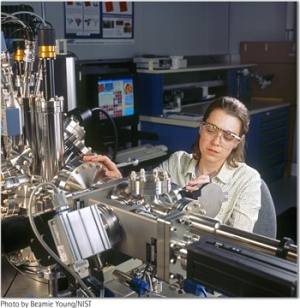New Methods & Tools Needed to Measure Exposure to Airborne Nanomaterials
 WASHINGTON, DC—New methods and tools for measuring exposure to airborne engineered nanomaterials will be required to protect the health of workers in nanotechnology-related jobs— estimated to total 10 million people by 2014—according to two occupational health experts writing in the inaugural issue of the journal Nanotoxicology.
WASHINGTON, DC—New methods and tools for measuring exposure to airborne engineered nanomaterials will be required to protect the health of workers in nanotechnology-related jobs— estimated to total 10 million people by 2014—according to two occupational health experts writing in the inaugural issue of the journal Nanotoxicology.
The article, “Assessing Exposure to Airborne Nanomaterials: Current Abilities and Future Requirements,” written by Andrew Maynard, chief science advisor at the Wilson Center’s Project on Emerging Nanotechnologies, and Robert Aitken, director of strategic consulting at the Institute of Occupational Medicine (Edinburgh, UK), can be viewed online at http://www.nanotoxicology.net
“Airborne engineered nanomaterials present complex exposure measurement challenges,” Maynard said. “Conventional approaches—measuring the mass of airborne material—will not always be sufficient. This presents a challenge because studies have indicated that, on a mass-for-mass basis, certain nanometer-scale particles may be more toxic than larger particles with a similar composition. In other words, smaller particles may be more harmful than conventional thinking would lead us to believe.”
Maynard and Aitken reduced the incredibly diverse set of possible engineered nanoparticles into nine distinct categories, ranging from very simple spherical particles to complex multifunctional particles. By pairing these categories with particle properties associated with potential health effects, they teased out possible monitoring approaches for each particle-property combination.
“What our analysis shows is that in the complex new ‘nano world’ there is no single or simple method for monitoring nanoaerosol exposures in order to assess and manage potential health effects,” Aitken explained. “There are instruments that present partial solutions to the measurement challenges we face. But at the end of the day, we lack the tools and devices that are sophisticated, cost-effective and fast enough to do the job.”
Maynard and Aitken conclude that current approaches of measuring the number of particles in a volume of air, surface areas, and mass concentration, will all be useful to some degree. However, further research is needed to identify which is most important for specific nanomaterials and which measurement methods are most effective.
The authors advocate developing a new “universal aerosol monitor” capable of providing detailed information on the nature of airborne engineered nanomaterials to which people are exposed. Maynard, Aitken and 12 other experts included development of such a versatile measurement tool among five grand challenges that they viewed as essential to achieving the safe handling of nanotechnology in an article that appeared in the November 16, 2006 issue of the journal Nature.
The proposed wearable sampling device would measure aerosol number, surface area, and concentration mass simultaneously and would be low cost. Today, stand-alone instruments can perform the individual types of measurements called for by Maynard and Aitken. “Bringing these technologies together into a single package within the size and cost parameters discussed does present a significant challenge,” they write.
“An economical integrated device will empower small and large nanotechnology industries alike to reduce uncertainty over what their workers are exposed to, and enable them to develop safer working environments” said Maynard. “This will require targeted research into developing new methodologies and new instruments. But the rapid advancement and commercialization of nanotechnologies are leading to the need for effective—if not necessarily perfect—exposure measurement approaches and devices to be developed as soon as possible.”
In 2005, nanotechnology was incorporated into $30 billion in manufactured goods—a number predicted to grow to $2.6 trillion in annual manufactured goods by 2014. Already, there are almost 400 manufacturer-identified nanotechnology-based consumer products on the market—ranging from computer chips to automobile parts and from clothing to cosmetics and dietary supplements. View an inventory of these products here: http://www.nanotechproject.tech/consumerproducts
April 17, 2007
Related
- View article: Assessing Exposure to Airborne Nanomaterials: Current Abilities and Future Requirements
